Inter-professional and Collaborative Practice Reflection Report
VerifiedAdded on 2021/01/06
|12
|3292
|40
Report
AI Summary
This report presents a reflection on inter-professional and collaborative practice within the NHS in the UK, focusing on a critical incident from a student's clinical practice. The report utilizes Driscoll's reflective model to analyze the experience of recording vital signs for a post-operative patient. It describes the incident, explores feelings of anxiety and inexperience, and evaluates the importance of communication, teamwork, and equipment functionality in providing effective patient care. The reflection highlights the significance of inter-professional relationships, patient consent, and the proper use of medical equipment. The report concludes with an analysis of the learning outcomes and the actions needed to improve future practice, emphasizing the need for enhanced communication skills, equipment checks, and meticulous record-keeping to ensure patient safety and quality care.
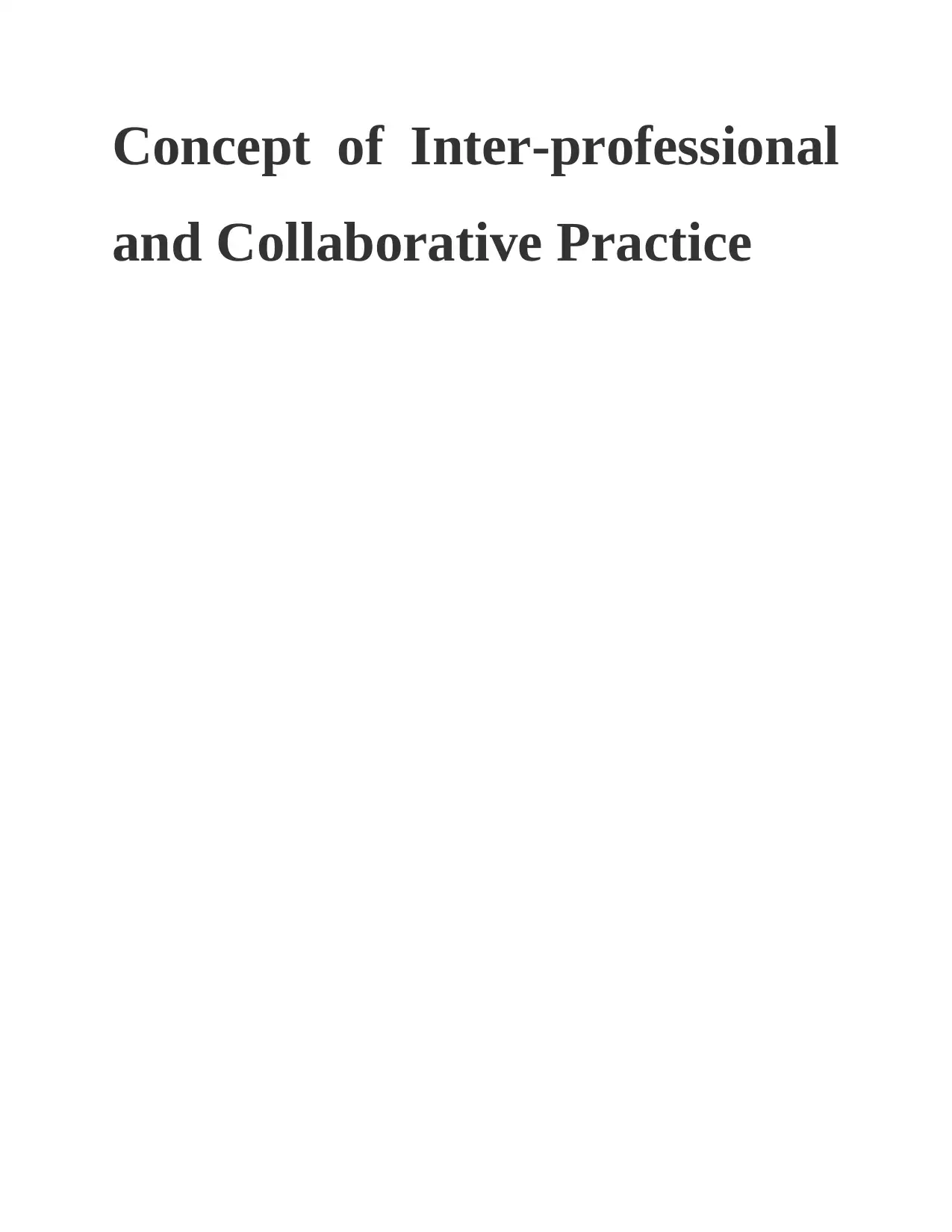
Concept of Inter-professional
and Collaborative Practice
and Collaborative Practice
Paraphrase This Document
Need a fresh take? Get an instant paraphrase of this document with our AI Paraphraser
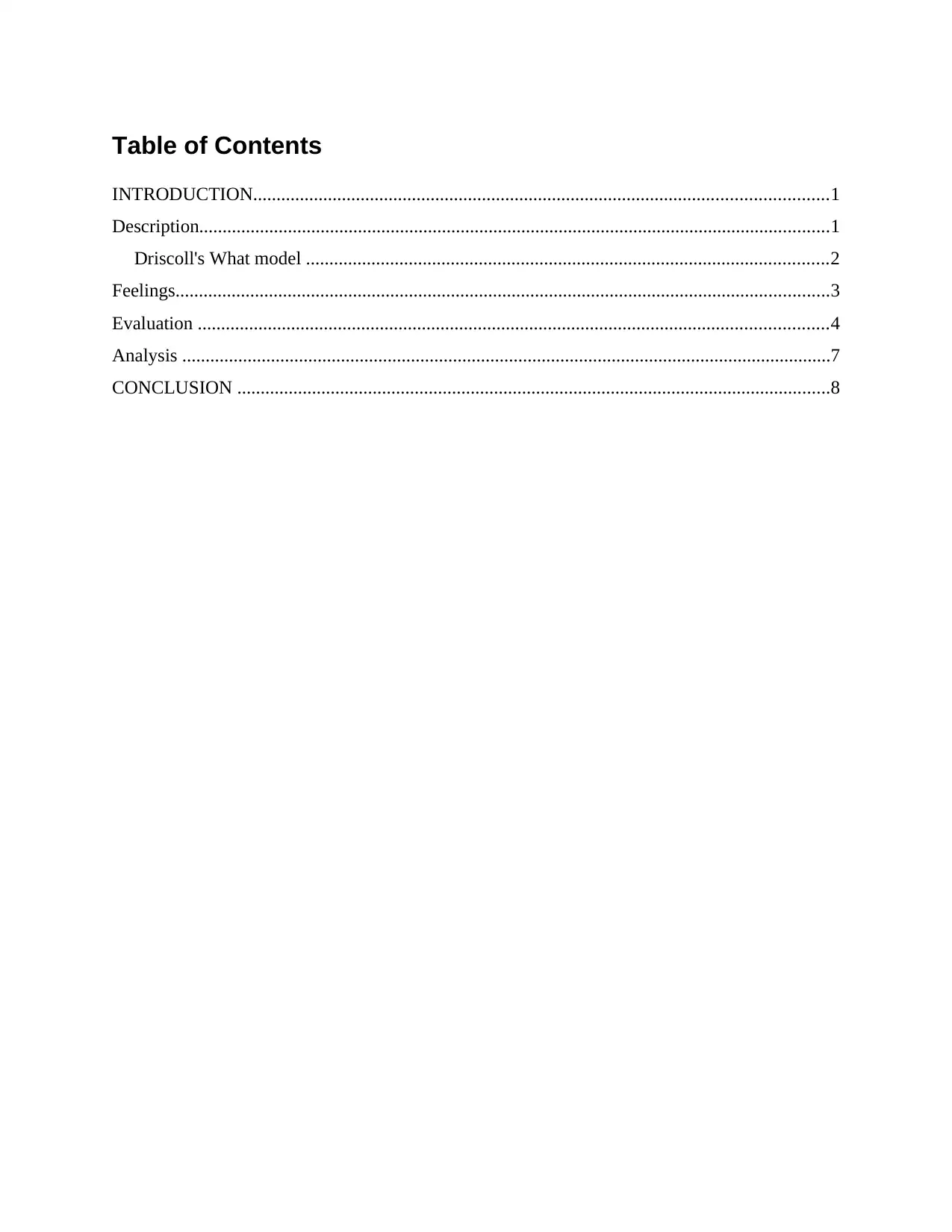
Table of Contents
INTRODUCTION...........................................................................................................................1
Description.......................................................................................................................................1
Driscoll's What model ................................................................................................................2
Feelings............................................................................................................................................3
Evaluation .......................................................................................................................................4
Analysis ...........................................................................................................................................7
CONCLUSION ...............................................................................................................................8
INTRODUCTION...........................................................................................................................1
Description.......................................................................................................................................1
Driscoll's What model ................................................................................................................2
Feelings............................................................................................................................................3
Evaluation .......................................................................................................................................4
Analysis ...........................................................................................................................................7
CONCLUSION ...............................................................................................................................8
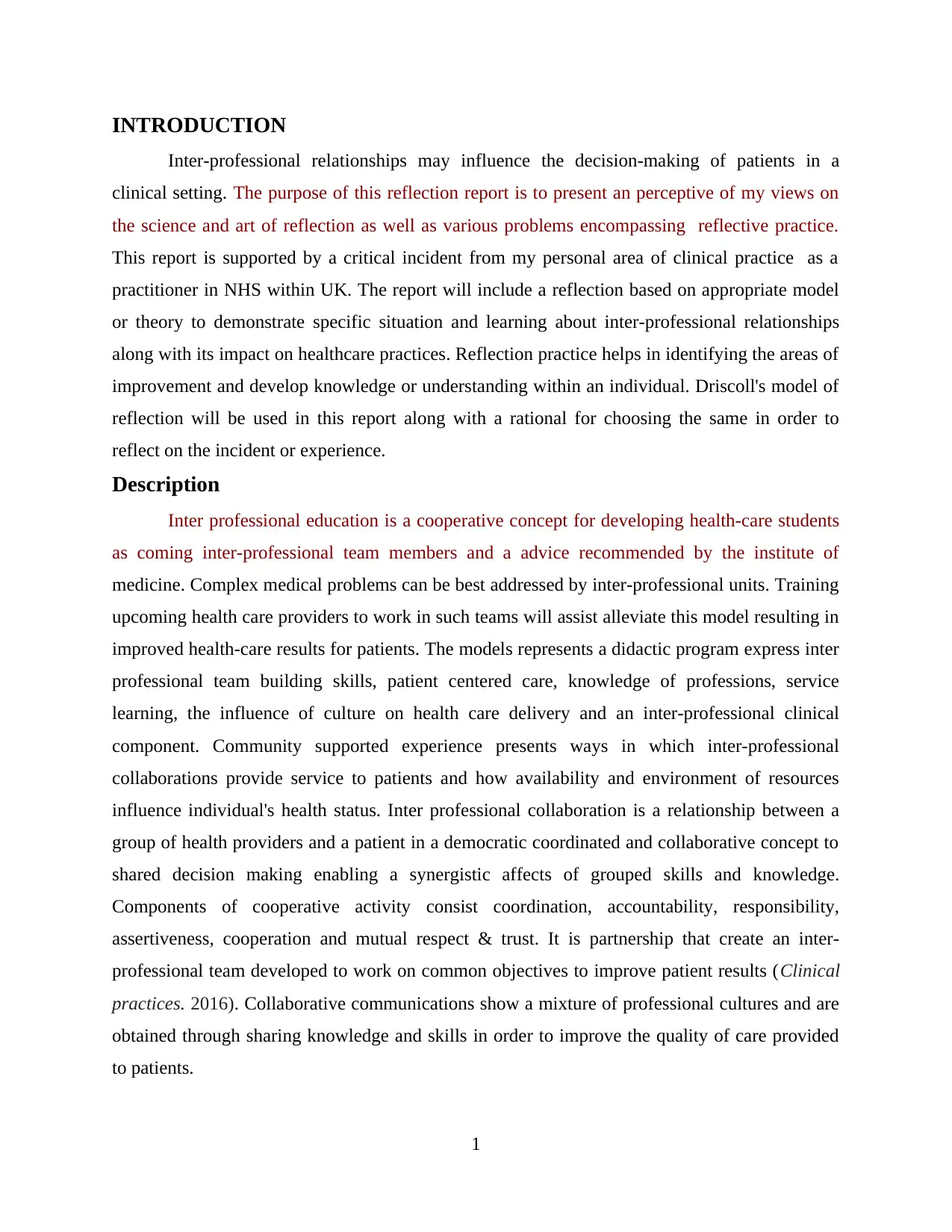
INTRODUCTION
Inter-professional relationships may influence the decision-making of patients in a
clinical setting. The purpose of this reflection report is to present an perceptive of my views on
the science and art of reflection as well as various problems encompassing reflective practice.
This report is supported by a critical incident from my personal area of clinical practice as a
practitioner in NHS within UK. The report will include a reflection based on appropriate model
or theory to demonstrate specific situation and learning about inter-professional relationships
along with its impact on healthcare practices. Reflection practice helps in identifying the areas of
improvement and develop knowledge or understanding within an individual. Driscoll's model of
reflection will be used in this report along with a rational for choosing the same in order to
reflect on the incident or experience.
Description
Inter professional education is a cooperative concept for developing health-care students
as coming inter-professional team members and a advice recommended by the institute of
medicine. Complex medical problems can be best addressed by inter-professional units. Training
upcoming health care providers to work in such teams will assist alleviate this model resulting in
improved health-care results for patients. The models represents a didactic program express inter
professional team building skills, patient centered care, knowledge of professions, service
learning, the influence of culture on health care delivery and an inter-professional clinical
component. Community supported experience presents ways in which inter-professional
collaborations provide service to patients and how availability and environment of resources
influence individual's health status. Inter professional collaboration is a relationship between a
group of health providers and a patient in a democratic coordinated and collaborative concept to
shared decision making enabling a synergistic affects of grouped skills and knowledge.
Components of cooperative activity consist coordination, accountability, responsibility,
assertiveness, cooperation and mutual respect & trust. It is partnership that create an inter-
professional team developed to work on common objectives to improve patient results (Clinical
practices. 2016). Collaborative communications show a mixture of professional cultures and are
obtained through sharing knowledge and skills in order to improve the quality of care provided
to patients.
1
Inter-professional relationships may influence the decision-making of patients in a
clinical setting. The purpose of this reflection report is to present an perceptive of my views on
the science and art of reflection as well as various problems encompassing reflective practice.
This report is supported by a critical incident from my personal area of clinical practice as a
practitioner in NHS within UK. The report will include a reflection based on appropriate model
or theory to demonstrate specific situation and learning about inter-professional relationships
along with its impact on healthcare practices. Reflection practice helps in identifying the areas of
improvement and develop knowledge or understanding within an individual. Driscoll's model of
reflection will be used in this report along with a rational for choosing the same in order to
reflect on the incident or experience.
Description
Inter professional education is a cooperative concept for developing health-care students
as coming inter-professional team members and a advice recommended by the institute of
medicine. Complex medical problems can be best addressed by inter-professional units. Training
upcoming health care providers to work in such teams will assist alleviate this model resulting in
improved health-care results for patients. The models represents a didactic program express inter
professional team building skills, patient centered care, knowledge of professions, service
learning, the influence of culture on health care delivery and an inter-professional clinical
component. Community supported experience presents ways in which inter-professional
collaborations provide service to patients and how availability and environment of resources
influence individual's health status. Inter professional collaboration is a relationship between a
group of health providers and a patient in a democratic coordinated and collaborative concept to
shared decision making enabling a synergistic affects of grouped skills and knowledge.
Components of cooperative activity consist coordination, accountability, responsibility,
assertiveness, cooperation and mutual respect & trust. It is partnership that create an inter-
professional team developed to work on common objectives to improve patient results (Clinical
practices. 2016). Collaborative communications show a mixture of professional cultures and are
obtained through sharing knowledge and skills in order to improve the quality of care provided
to patients.
1
⊘ This is a preview!⊘
Do you want full access?
Subscribe today to unlock all pages.

Trusted by 1+ million students worldwide
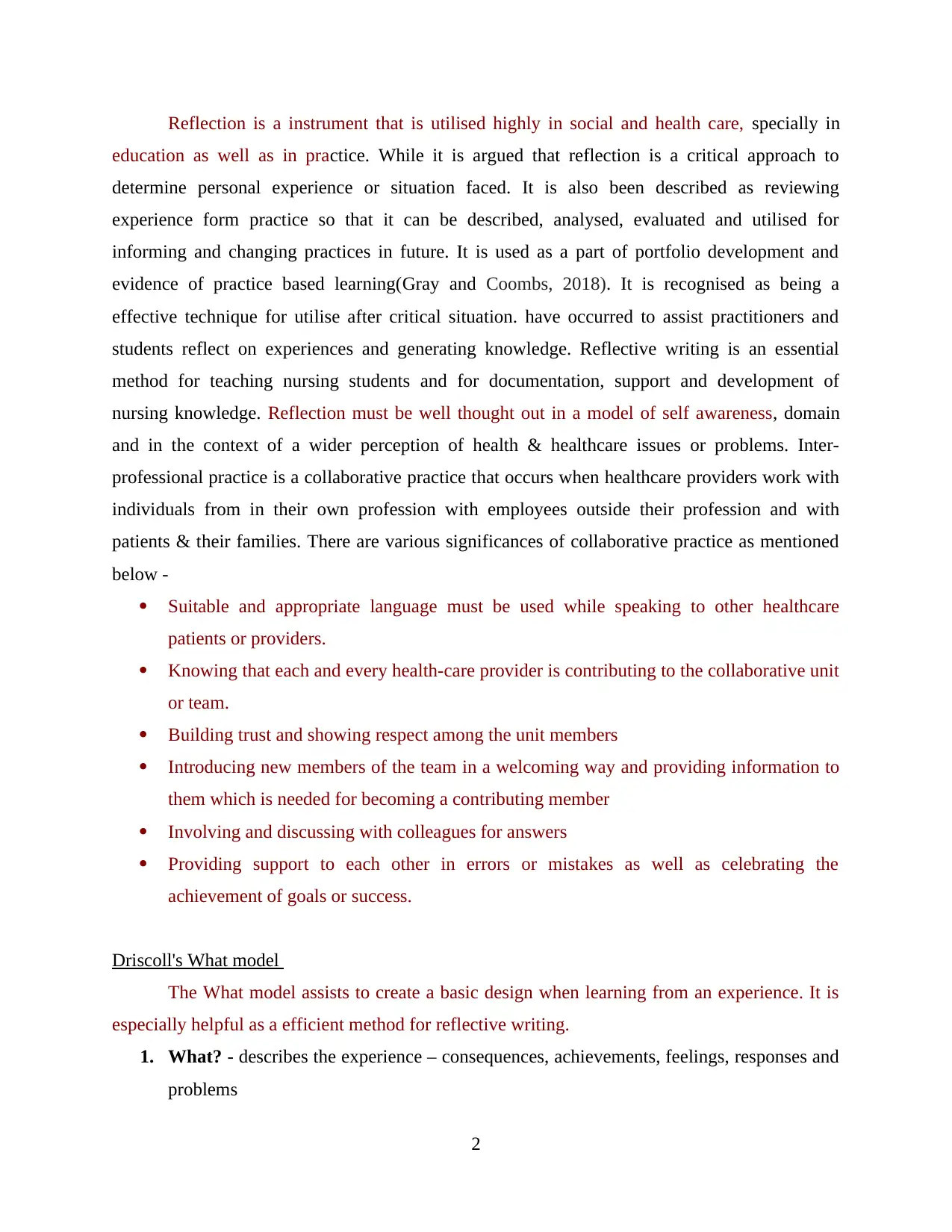
Reflection is a instrument that is utilised highly in social and health care, specially in
education as well as in practice. While it is argued that reflection is a critical approach to
determine personal experience or situation faced. It is also been described as reviewing
experience form practice so that it can be described, analysed, evaluated and utilised for
informing and changing practices in future. It is used as a part of portfolio development and
evidence of practice based learning(Gray and Coombs, 2018). It is recognised as being a
effective technique for utilise after critical situation. have occurred to assist practitioners and
students reflect on experiences and generating knowledge. Reflective writing is an essential
method for teaching nursing students and for documentation, support and development of
nursing knowledge. Reflection must be well thought out in a model of self awareness, domain
and in the context of a wider perception of health & healthcare issues or problems. Inter-
professional practice is a collaborative practice that occurs when healthcare providers work with
individuals from in their own profession with employees outside their profession and with
patients & their families. There are various significances of collaborative practice as mentioned
below -
Suitable and appropriate language must be used while speaking to other healthcare
patients or providers.
Knowing that each and every health-care provider is contributing to the collaborative unit
or team.
Building trust and showing respect among the unit members
Introducing new members of the team in a welcoming way and providing information to
them which is needed for becoming a contributing member
Involving and discussing with colleagues for answers
Providing support to each other in errors or mistakes as well as celebrating the
achievement of goals or success.
Driscoll's What model
The What model assists to create a basic design when learning from an experience. It is
especially helpful as a efficient method for reflective writing.
1. What? - describes the experience – consequences, achievements, feelings, responses and
problems
2
education as well as in practice. While it is argued that reflection is a critical approach to
determine personal experience or situation faced. It is also been described as reviewing
experience form practice so that it can be described, analysed, evaluated and utilised for
informing and changing practices in future. It is used as a part of portfolio development and
evidence of practice based learning(Gray and Coombs, 2018). It is recognised as being a
effective technique for utilise after critical situation. have occurred to assist practitioners and
students reflect on experiences and generating knowledge. Reflective writing is an essential
method for teaching nursing students and for documentation, support and development of
nursing knowledge. Reflection must be well thought out in a model of self awareness, domain
and in the context of a wider perception of health & healthcare issues or problems. Inter-
professional practice is a collaborative practice that occurs when healthcare providers work with
individuals from in their own profession with employees outside their profession and with
patients & their families. There are various significances of collaborative practice as mentioned
below -
Suitable and appropriate language must be used while speaking to other healthcare
patients or providers.
Knowing that each and every health-care provider is contributing to the collaborative unit
or team.
Building trust and showing respect among the unit members
Introducing new members of the team in a welcoming way and providing information to
them which is needed for becoming a contributing member
Involving and discussing with colleagues for answers
Providing support to each other in errors or mistakes as well as celebrating the
achievement of goals or success.
Driscoll's What model
The What model assists to create a basic design when learning from an experience. It is
especially helpful as a efficient method for reflective writing.
1. What? - describes the experience – consequences, achievements, feelings, responses and
problems
2
Paraphrase This Document
Need a fresh take? Get an instant paraphrase of this document with our AI Paraphraser
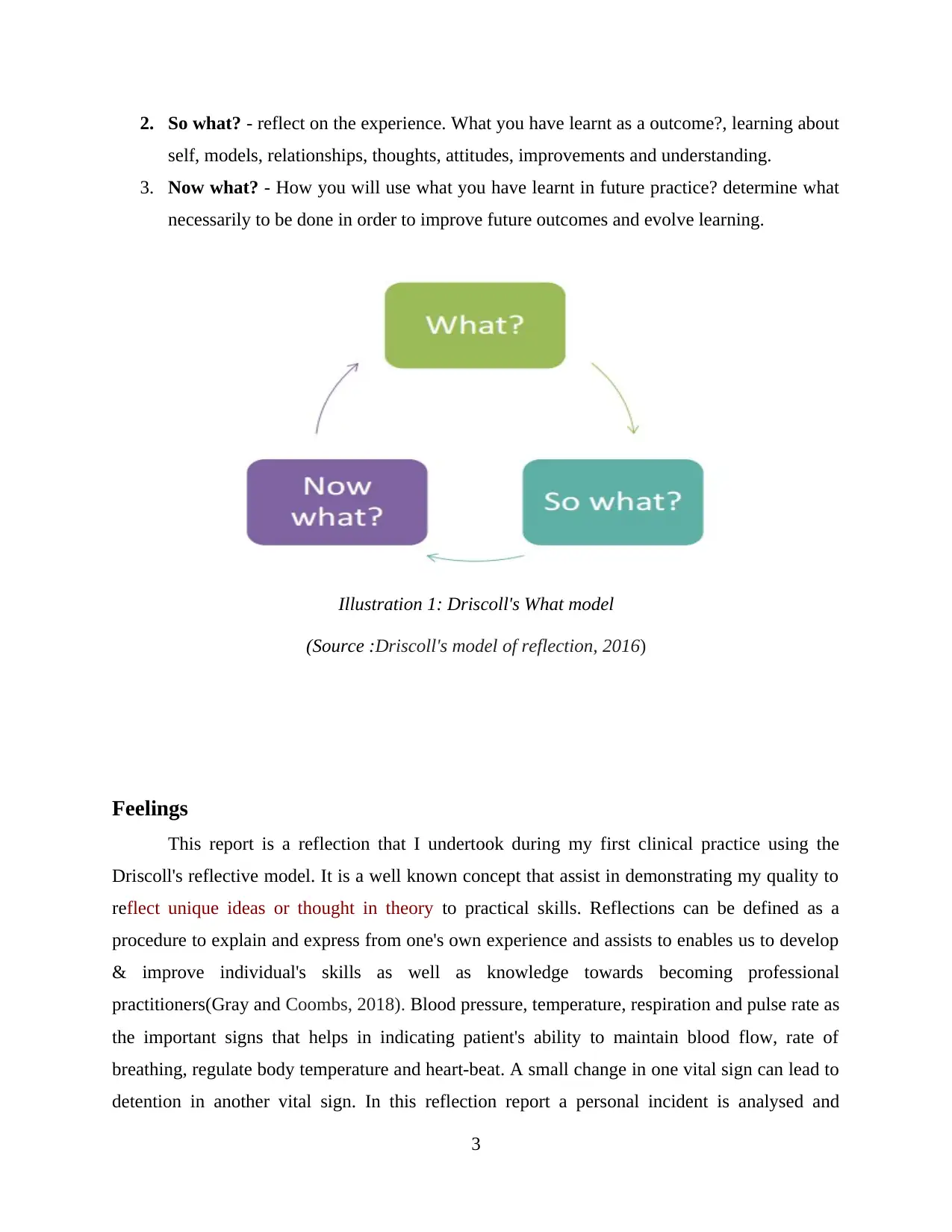
2. So what? - reflect on the experience. What you have learnt as a outcome?, learning about
self, models, relationships, thoughts, attitudes, improvements and understanding.
3. Now what? - How you will use what you have learnt in future practice? determine what
necessarily to be done in order to improve future outcomes and evolve learning.
Feelings
This report is a reflection that I undertook during my first clinical practice using the
Driscoll's reflective model. It is a well known concept that assist in demonstrating my quality to
reflect unique ideas or thought in theory to practical skills. Reflections can be defined as a
procedure to explain and express from one's own experience and assists to enables us to develop
& improve individual's skills as well as knowledge towards becoming professional
practitioners(Gray and Coombs, 2018). Blood pressure, temperature, respiration and pulse rate as
the important signs that helps in indicating patient's ability to maintain blood flow, rate of
breathing, regulate body temperature and heart-beat. A small change in one vital sign can lead to
detention in another vital sign. In this reflection report a personal incident is analysed and
3
Illustration 1: Driscoll's What model
(Source :Driscoll's model of reflection, 2016)
self, models, relationships, thoughts, attitudes, improvements and understanding.
3. Now what? - How you will use what you have learnt in future practice? determine what
necessarily to be done in order to improve future outcomes and evolve learning.
Feelings
This report is a reflection that I undertook during my first clinical practice using the
Driscoll's reflective model. It is a well known concept that assist in demonstrating my quality to
reflect unique ideas or thought in theory to practical skills. Reflections can be defined as a
procedure to explain and express from one's own experience and assists to enables us to develop
& improve individual's skills as well as knowledge towards becoming professional
practitioners(Gray and Coombs, 2018). Blood pressure, temperature, respiration and pulse rate as
the important signs that helps in indicating patient's ability to maintain blood flow, rate of
breathing, regulate body temperature and heart-beat. A small change in one vital sign can lead to
detention in another vital sign. In this reflection report a personal incident is analysed and
3
Illustration 1: Driscoll's What model
(Source :Driscoll's model of reflection, 2016)
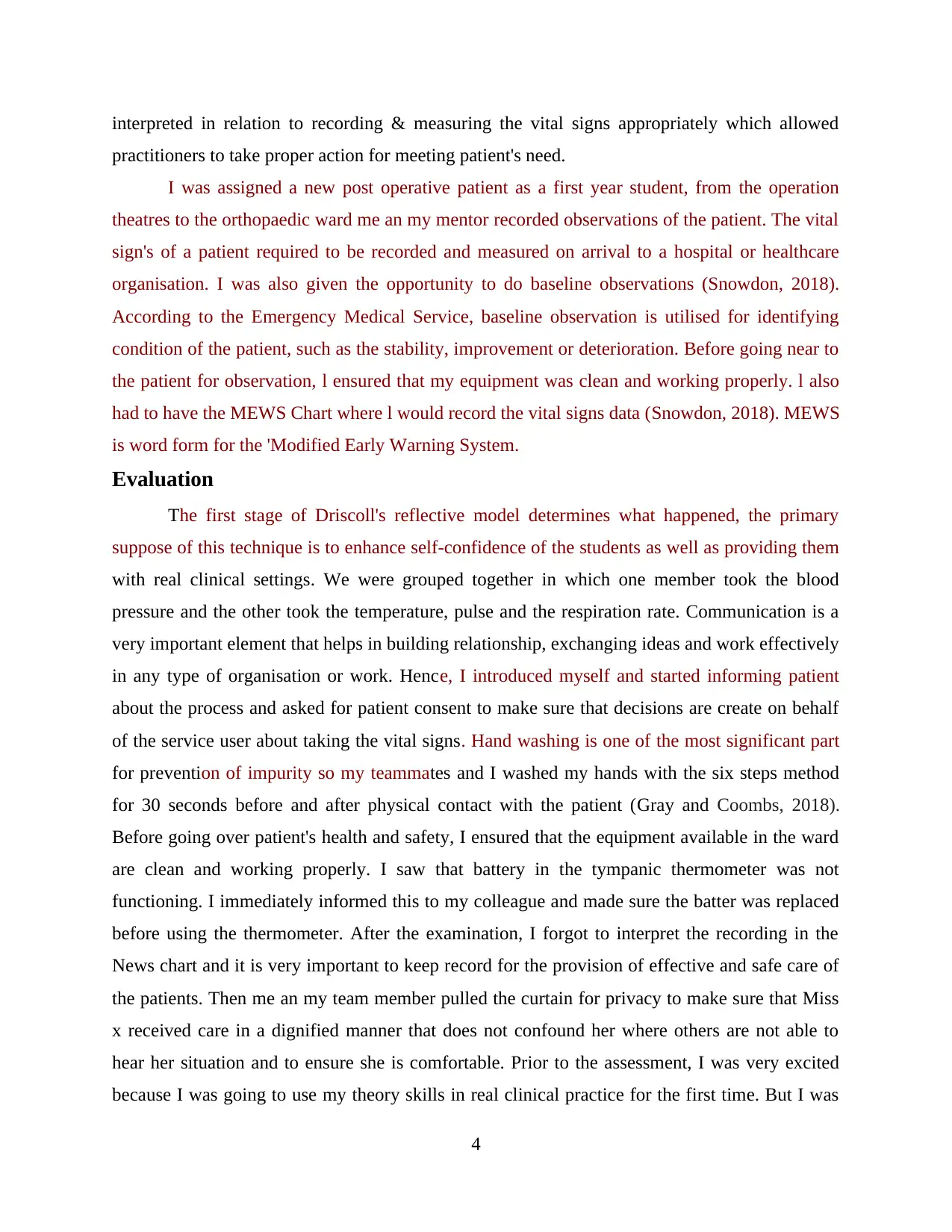
interpreted in relation to recording & measuring the vital signs appropriately which allowed
practitioners to take proper action for meeting patient's need.
I was assigned a new post operative patient as a first year student, from the operation
theatres to the orthopaedic ward me an my mentor recorded observations of the patient. The vital
sign's of a patient required to be recorded and measured on arrival to a hospital or healthcare
organisation. I was also given the opportunity to do baseline observations (Snowdon, 2018).
According to the Emergency Medical Service, baseline observation is utilised for identifying
condition of the patient, such as the stability, improvement or deterioration. Before going near to
the patient for observation, l ensured that my equipment was clean and working properly. l also
had to have the MEWS Chart where l would record the vital signs data (Snowdon, 2018). MEWS
is word form for the 'Modified Early Warning System.
Evaluation
The first stage of Driscoll's reflective model determines what happened, the primary
suppose of this technique is to enhance self-confidence of the students as well as providing them
with real clinical settings. We were grouped together in which one member took the blood
pressure and the other took the temperature, pulse and the respiration rate. Communication is a
very important element that helps in building relationship, exchanging ideas and work effectively
in any type of organisation or work. Hence, I introduced myself and started informing patient
about the process and asked for patient consent to make sure that decisions are create on behalf
of the service user about taking the vital signs. Hand washing is one of the most significant part
for prevention of impurity so my teammates and I washed my hands with the six steps method
for 30 seconds before and after physical contact with the patient (Gray and Coombs, 2018).
Before going over patient's health and safety, I ensured that the equipment available in the ward
are clean and working properly. I saw that battery in the tympanic thermometer was not
functioning. I immediately informed this to my colleague and made sure the batter was replaced
before using the thermometer. After the examination, I forgot to interpret the recording in the
News chart and it is very important to keep record for the provision of effective and safe care of
the patients. Then me an my team member pulled the curtain for privacy to make sure that Miss
x received care in a dignified manner that does not confound her where others are not able to
hear her situation and to ensure she is comfortable. Prior to the assessment, I was very excited
because I was going to use my theory skills in real clinical practice for the first time. But I was
4
practitioners to take proper action for meeting patient's need.
I was assigned a new post operative patient as a first year student, from the operation
theatres to the orthopaedic ward me an my mentor recorded observations of the patient. The vital
sign's of a patient required to be recorded and measured on arrival to a hospital or healthcare
organisation. I was also given the opportunity to do baseline observations (Snowdon, 2018).
According to the Emergency Medical Service, baseline observation is utilised for identifying
condition of the patient, such as the stability, improvement or deterioration. Before going near to
the patient for observation, l ensured that my equipment was clean and working properly. l also
had to have the MEWS Chart where l would record the vital signs data (Snowdon, 2018). MEWS
is word form for the 'Modified Early Warning System.
Evaluation
The first stage of Driscoll's reflective model determines what happened, the primary
suppose of this technique is to enhance self-confidence of the students as well as providing them
with real clinical settings. We were grouped together in which one member took the blood
pressure and the other took the temperature, pulse and the respiration rate. Communication is a
very important element that helps in building relationship, exchanging ideas and work effectively
in any type of organisation or work. Hence, I introduced myself and started informing patient
about the process and asked for patient consent to make sure that decisions are create on behalf
of the service user about taking the vital signs. Hand washing is one of the most significant part
for prevention of impurity so my teammates and I washed my hands with the six steps method
for 30 seconds before and after physical contact with the patient (Gray and Coombs, 2018).
Before going over patient's health and safety, I ensured that the equipment available in the ward
are clean and working properly. I saw that battery in the tympanic thermometer was not
functioning. I immediately informed this to my colleague and made sure the batter was replaced
before using the thermometer. After the examination, I forgot to interpret the recording in the
News chart and it is very important to keep record for the provision of effective and safe care of
the patients. Then me an my team member pulled the curtain for privacy to make sure that Miss
x received care in a dignified manner that does not confound her where others are not able to
hear her situation and to ensure she is comfortable. Prior to the assessment, I was very excited
because I was going to use my theory skills in real clinical practice for the first time. But I was
4
⊘ This is a preview!⊘
Do you want full access?
Subscribe today to unlock all pages.

Trusted by 1+ million students worldwide
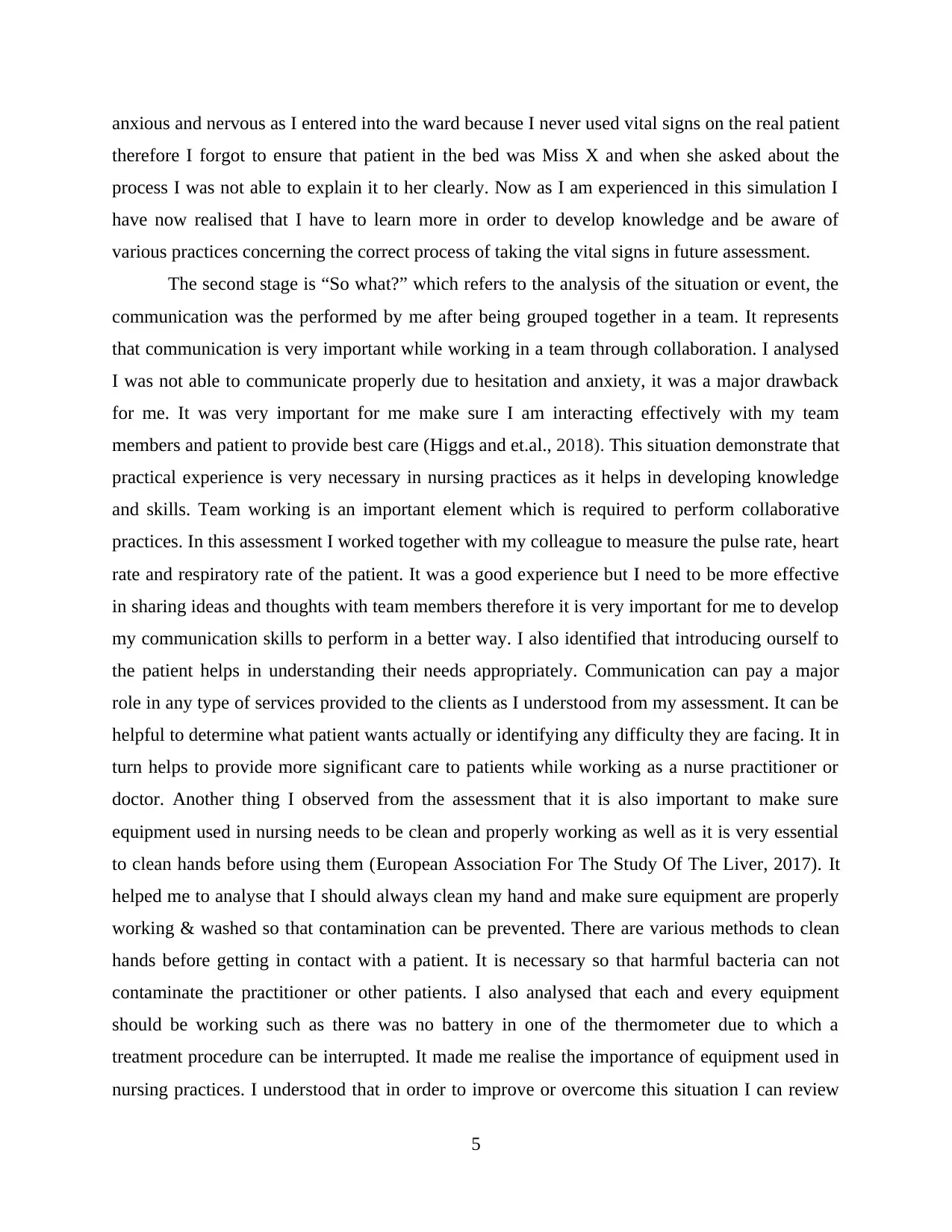
anxious and nervous as I entered into the ward because I never used vital signs on the real patient
therefore I forgot to ensure that patient in the bed was Miss X and when she asked about the
process I was not able to explain it to her clearly. Now as I am experienced in this simulation I
have now realised that I have to learn more in order to develop knowledge and be aware of
various practices concerning the correct process of taking the vital signs in future assessment.
The second stage is “So what?” which refers to the analysis of the situation or event, the
communication was the performed by me after being grouped together in a team. It represents
that communication is very important while working in a team through collaboration. I analysed
I was not able to communicate properly due to hesitation and anxiety, it was a major drawback
for me. It was very important for me make sure I am interacting effectively with my team
members and patient to provide best care (Higgs and et.al., 2018). This situation demonstrate that
practical experience is very necessary in nursing practices as it helps in developing knowledge
and skills. Team working is an important element which is required to perform collaborative
practices. In this assessment I worked together with my colleague to measure the pulse rate, heart
rate and respiratory rate of the patient. It was a good experience but I need to be more effective
in sharing ideas and thoughts with team members therefore it is very important for me to develop
my communication skills to perform in a better way. I also identified that introducing ourself to
the patient helps in understanding their needs appropriately. Communication can pay a major
role in any type of services provided to the clients as I understood from my assessment. It can be
helpful to determine what patient wants actually or identifying any difficulty they are facing. It in
turn helps to provide more significant care to patients while working as a nurse practitioner or
doctor. Another thing I observed from the assessment that it is also important to make sure
equipment used in nursing needs to be clean and properly working as well as it is very essential
to clean hands before using them (European Association For The Study Of The Liver, 2017). It
helped me to analyse that I should always clean my hand and make sure equipment are properly
working & washed so that contamination can be prevented. There are various methods to clean
hands before getting in contact with a patient. It is necessary so that harmful bacteria can not
contaminate the practitioner or other patients. I also analysed that each and every equipment
should be working such as there was no battery in one of the thermometer due to which a
treatment procedure can be interrupted. It made me realise the importance of equipment used in
nursing practices. I understood that in order to improve or overcome this situation I can review
5
therefore I forgot to ensure that patient in the bed was Miss X and when she asked about the
process I was not able to explain it to her clearly. Now as I am experienced in this simulation I
have now realised that I have to learn more in order to develop knowledge and be aware of
various practices concerning the correct process of taking the vital signs in future assessment.
The second stage is “So what?” which refers to the analysis of the situation or event, the
communication was the performed by me after being grouped together in a team. It represents
that communication is very important while working in a team through collaboration. I analysed
I was not able to communicate properly due to hesitation and anxiety, it was a major drawback
for me. It was very important for me make sure I am interacting effectively with my team
members and patient to provide best care (Higgs and et.al., 2018). This situation demonstrate that
practical experience is very necessary in nursing practices as it helps in developing knowledge
and skills. Team working is an important element which is required to perform collaborative
practices. In this assessment I worked together with my colleague to measure the pulse rate, heart
rate and respiratory rate of the patient. It was a good experience but I need to be more effective
in sharing ideas and thoughts with team members therefore it is very important for me to develop
my communication skills to perform in a better way. I also identified that introducing ourself to
the patient helps in understanding their needs appropriately. Communication can pay a major
role in any type of services provided to the clients as I understood from my assessment. It can be
helpful to determine what patient wants actually or identifying any difficulty they are facing. It in
turn helps to provide more significant care to patients while working as a nurse practitioner or
doctor. Another thing I observed from the assessment that it is also important to make sure
equipment used in nursing needs to be clean and properly working as well as it is very essential
to clean hands before using them (European Association For The Study Of The Liver, 2017). It
helped me to analyse that I should always clean my hand and make sure equipment are properly
working & washed so that contamination can be prevented. There are various methods to clean
hands before getting in contact with a patient. It is necessary so that harmful bacteria can not
contaminate the practitioner or other patients. I also analysed that each and every equipment
should be working such as there was no battery in one of the thermometer due to which a
treatment procedure can be interrupted. It made me realise the importance of equipment used in
nursing practices. I understood that in order to improve or overcome this situation I can review
5
Paraphrase This Document
Need a fresh take? Get an instant paraphrase of this document with our AI Paraphraser
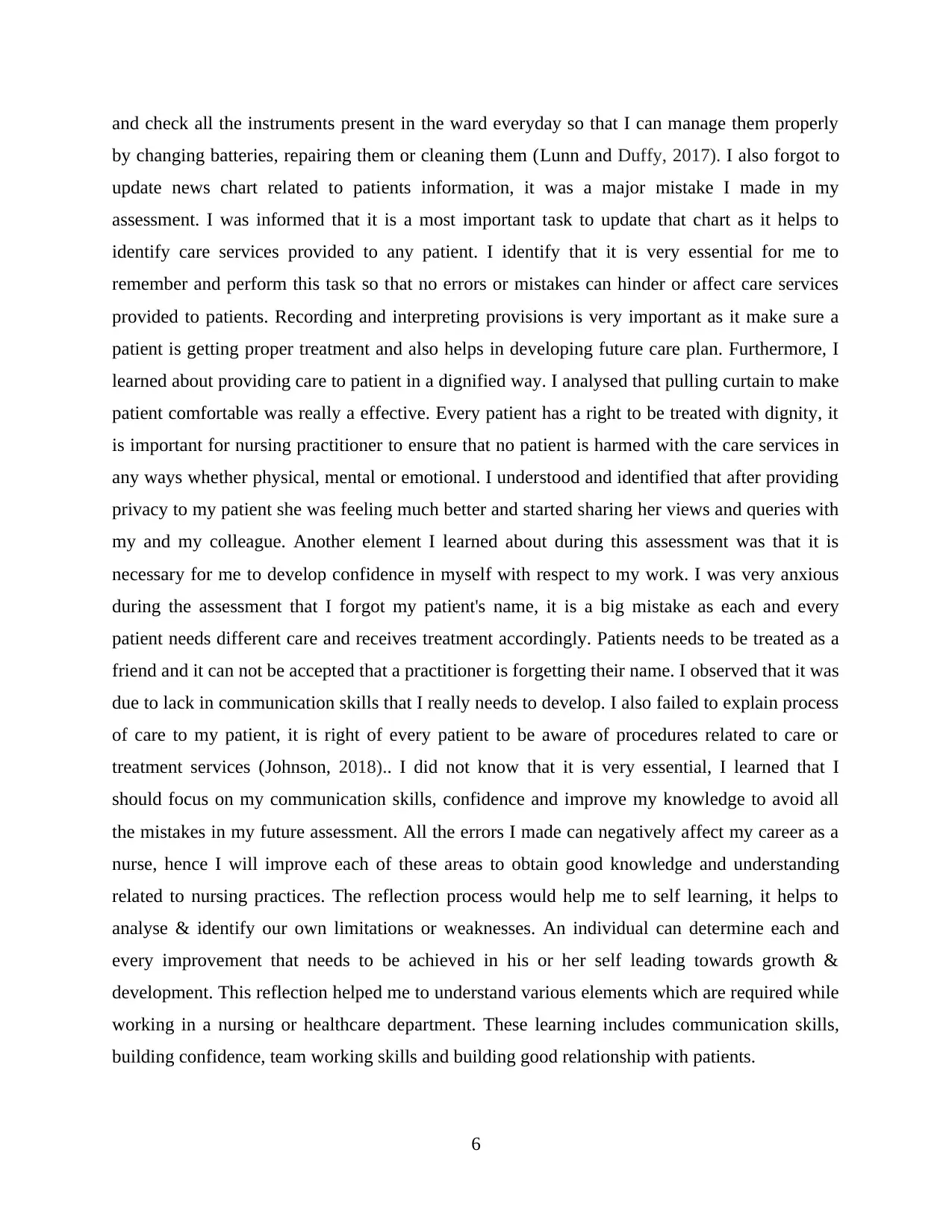
and check all the instruments present in the ward everyday so that I can manage them properly
by changing batteries, repairing them or cleaning them (Lunn and Duffy, 2017). I also forgot to
update news chart related to patients information, it was a major mistake I made in my
assessment. I was informed that it is a most important task to update that chart as it helps to
identify care services provided to any patient. I identify that it is very essential for me to
remember and perform this task so that no errors or mistakes can hinder or affect care services
provided to patients. Recording and interpreting provisions is very important as it make sure a
patient is getting proper treatment and also helps in developing future care plan. Furthermore, I
learned about providing care to patient in a dignified way. I analysed that pulling curtain to make
patient comfortable was really a effective. Every patient has a right to be treated with dignity, it
is important for nursing practitioner to ensure that no patient is harmed with the care services in
any ways whether physical, mental or emotional. I understood and identified that after providing
privacy to my patient she was feeling much better and started sharing her views and queries with
my and my colleague. Another element I learned about during this assessment was that it is
necessary for me to develop confidence in myself with respect to my work. I was very anxious
during the assessment that I forgot my patient's name, it is a big mistake as each and every
patient needs different care and receives treatment accordingly. Patients needs to be treated as a
friend and it can not be accepted that a practitioner is forgetting their name. I observed that it was
due to lack in communication skills that I really needs to develop. I also failed to explain process
of care to my patient, it is right of every patient to be aware of procedures related to care or
treatment services (Johnson, 2018).. I did not know that it is very essential, I learned that I
should focus on my communication skills, confidence and improve my knowledge to avoid all
the mistakes in my future assessment. All the errors I made can negatively affect my career as a
nurse, hence I will improve each of these areas to obtain good knowledge and understanding
related to nursing practices. The reflection process would help me to self learning, it helps to
analyse & identify our own limitations or weaknesses. An individual can determine each and
every improvement that needs to be achieved in his or her self leading towards growth &
development. This reflection helped me to understand various elements which are required while
working in a nursing or healthcare department. These learning includes communication skills,
building confidence, team working skills and building good relationship with patients.
6
by changing batteries, repairing them or cleaning them (Lunn and Duffy, 2017). I also forgot to
update news chart related to patients information, it was a major mistake I made in my
assessment. I was informed that it is a most important task to update that chart as it helps to
identify care services provided to any patient. I identify that it is very essential for me to
remember and perform this task so that no errors or mistakes can hinder or affect care services
provided to patients. Recording and interpreting provisions is very important as it make sure a
patient is getting proper treatment and also helps in developing future care plan. Furthermore, I
learned about providing care to patient in a dignified way. I analysed that pulling curtain to make
patient comfortable was really a effective. Every patient has a right to be treated with dignity, it
is important for nursing practitioner to ensure that no patient is harmed with the care services in
any ways whether physical, mental or emotional. I understood and identified that after providing
privacy to my patient she was feeling much better and started sharing her views and queries with
my and my colleague. Another element I learned about during this assessment was that it is
necessary for me to develop confidence in myself with respect to my work. I was very anxious
during the assessment that I forgot my patient's name, it is a big mistake as each and every
patient needs different care and receives treatment accordingly. Patients needs to be treated as a
friend and it can not be accepted that a practitioner is forgetting their name. I observed that it was
due to lack in communication skills that I really needs to develop. I also failed to explain process
of care to my patient, it is right of every patient to be aware of procedures related to care or
treatment services (Johnson, 2018).. I did not know that it is very essential, I learned that I
should focus on my communication skills, confidence and improve my knowledge to avoid all
the mistakes in my future assessment. All the errors I made can negatively affect my career as a
nurse, hence I will improve each of these areas to obtain good knowledge and understanding
related to nursing practices. The reflection process would help me to self learning, it helps to
analyse & identify our own limitations or weaknesses. An individual can determine each and
every improvement that needs to be achieved in his or her self leading towards growth &
development. This reflection helped me to understand various elements which are required while
working in a nursing or healthcare department. These learning includes communication skills,
building confidence, team working skills and building good relationship with patients.
6
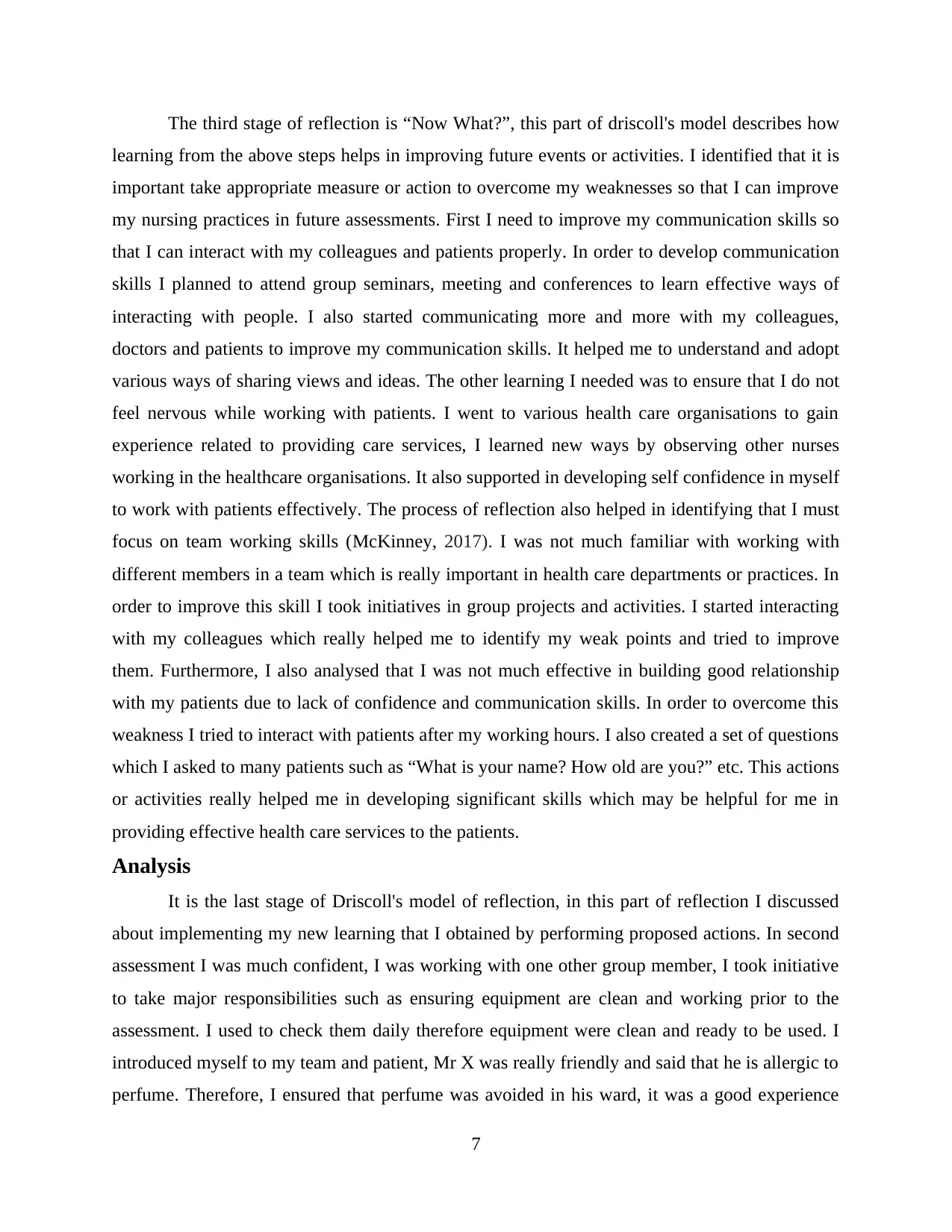
The third stage of reflection is “Now What?”, this part of driscoll's model describes how
learning from the above steps helps in improving future events or activities. I identified that it is
important take appropriate measure or action to overcome my weaknesses so that I can improve
my nursing practices in future assessments. First I need to improve my communication skills so
that I can interact with my colleagues and patients properly. In order to develop communication
skills I planned to attend group seminars, meeting and conferences to learn effective ways of
interacting with people. I also started communicating more and more with my colleagues,
doctors and patients to improve my communication skills. It helped me to understand and adopt
various ways of sharing views and ideas. The other learning I needed was to ensure that I do not
feel nervous while working with patients. I went to various health care organisations to gain
experience related to providing care services, I learned new ways by observing other nurses
working in the healthcare organisations. It also supported in developing self confidence in myself
to work with patients effectively. The process of reflection also helped in identifying that I must
focus on team working skills (McKinney, 2017). I was not much familiar with working with
different members in a team which is really important in health care departments or practices. In
order to improve this skill I took initiatives in group projects and activities. I started interacting
with my colleagues which really helped me to identify my weak points and tried to improve
them. Furthermore, I also analysed that I was not much effective in building good relationship
with my patients due to lack of confidence and communication skills. In order to overcome this
weakness I tried to interact with patients after my working hours. I also created a set of questions
which I asked to many patients such as “What is your name? How old are you?” etc. This actions
or activities really helped me in developing significant skills which may be helpful for me in
providing effective health care services to the patients.
Analysis
It is the last stage of Driscoll's model of reflection, in this part of reflection I discussed
about implementing my new learning that I obtained by performing proposed actions. In second
assessment I was much confident, I was working with one other group member, I took initiative
to take major responsibilities such as ensuring equipment are clean and working prior to the
assessment. I used to check them daily therefore equipment were clean and ready to be used. I
introduced myself to my team and patient, Mr X was really friendly and said that he is allergic to
perfume. Therefore, I ensured that perfume was avoided in his ward, it was a good experience
7
learning from the above steps helps in improving future events or activities. I identified that it is
important take appropriate measure or action to overcome my weaknesses so that I can improve
my nursing practices in future assessments. First I need to improve my communication skills so
that I can interact with my colleagues and patients properly. In order to develop communication
skills I planned to attend group seminars, meeting and conferences to learn effective ways of
interacting with people. I also started communicating more and more with my colleagues,
doctors and patients to improve my communication skills. It helped me to understand and adopt
various ways of sharing views and ideas. The other learning I needed was to ensure that I do not
feel nervous while working with patients. I went to various health care organisations to gain
experience related to providing care services, I learned new ways by observing other nurses
working in the healthcare organisations. It also supported in developing self confidence in myself
to work with patients effectively. The process of reflection also helped in identifying that I must
focus on team working skills (McKinney, 2017). I was not much familiar with working with
different members in a team which is really important in health care departments or practices. In
order to improve this skill I took initiatives in group projects and activities. I started interacting
with my colleagues which really helped me to identify my weak points and tried to improve
them. Furthermore, I also analysed that I was not much effective in building good relationship
with my patients due to lack of confidence and communication skills. In order to overcome this
weakness I tried to interact with patients after my working hours. I also created a set of questions
which I asked to many patients such as “What is your name? How old are you?” etc. This actions
or activities really helped me in developing significant skills which may be helpful for me in
providing effective health care services to the patients.
Analysis
It is the last stage of Driscoll's model of reflection, in this part of reflection I discussed
about implementing my new learning that I obtained by performing proposed actions. In second
assessment I was much confident, I was working with one other group member, I took initiative
to take major responsibilities such as ensuring equipment are clean and working prior to the
assessment. I used to check them daily therefore equipment were clean and ready to be used. I
introduced myself to my team and patient, Mr X was really friendly and said that he is allergic to
perfume. Therefore, I ensured that perfume was avoided in his ward, it was a good experience
7
⊘ This is a preview!⊘
Do you want full access?
Subscribe today to unlock all pages.

Trusted by 1+ million students worldwide
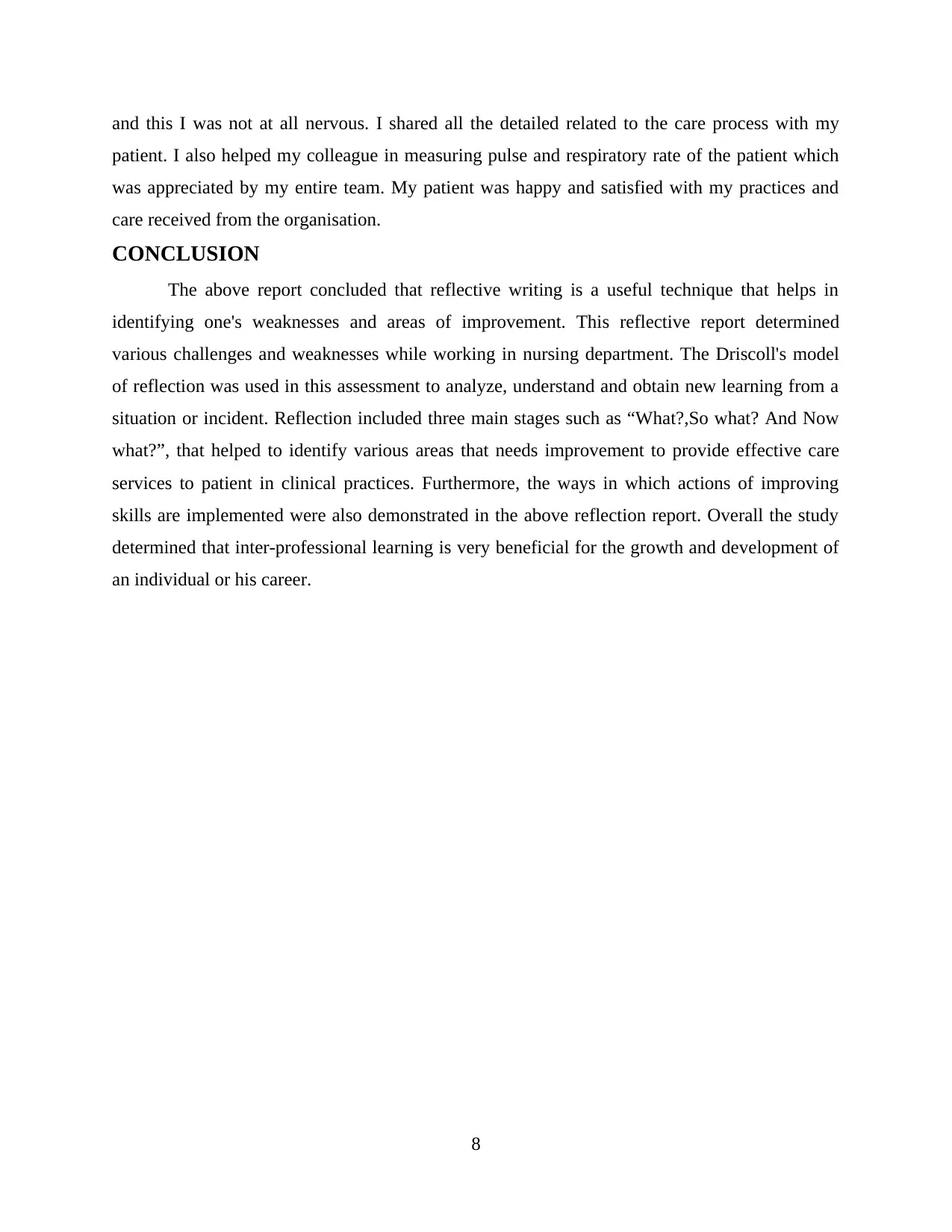
and this I was not at all nervous. I shared all the detailed related to the care process with my
patient. I also helped my colleague in measuring pulse and respiratory rate of the patient which
was appreciated by my entire team. My patient was happy and satisfied with my practices and
care received from the organisation.
CONCLUSION
The above report concluded that reflective writing is a useful technique that helps in
identifying one's weaknesses and areas of improvement. This reflective report determined
various challenges and weaknesses while working in nursing department. The Driscoll's model
of reflection was used in this assessment to analyze, understand and obtain new learning from a
situation or incident. Reflection included three main stages such as “What?,So what? And Now
what?”, that helped to identify various areas that needs improvement to provide effective care
services to patient in clinical practices. Furthermore, the ways in which actions of improving
skills are implemented were also demonstrated in the above reflection report. Overall the study
determined that inter-professional learning is very beneficial for the growth and development of
an individual or his career.
8
patient. I also helped my colleague in measuring pulse and respiratory rate of the patient which
was appreciated by my entire team. My patient was happy and satisfied with my practices and
care received from the organisation.
CONCLUSION
The above report concluded that reflective writing is a useful technique that helps in
identifying one's weaknesses and areas of improvement. This reflective report determined
various challenges and weaknesses while working in nursing department. The Driscoll's model
of reflection was used in this assessment to analyze, understand and obtain new learning from a
situation or incident. Reflection included three main stages such as “What?,So what? And Now
what?”, that helped to identify various areas that needs improvement to provide effective care
services to patient in clinical practices. Furthermore, the ways in which actions of improving
skills are implemented were also demonstrated in the above reflection report. Overall the study
determined that inter-professional learning is very beneficial for the growth and development of
an individual or his career.
8
Paraphrase This Document
Need a fresh take? Get an instant paraphrase of this document with our AI Paraphraser
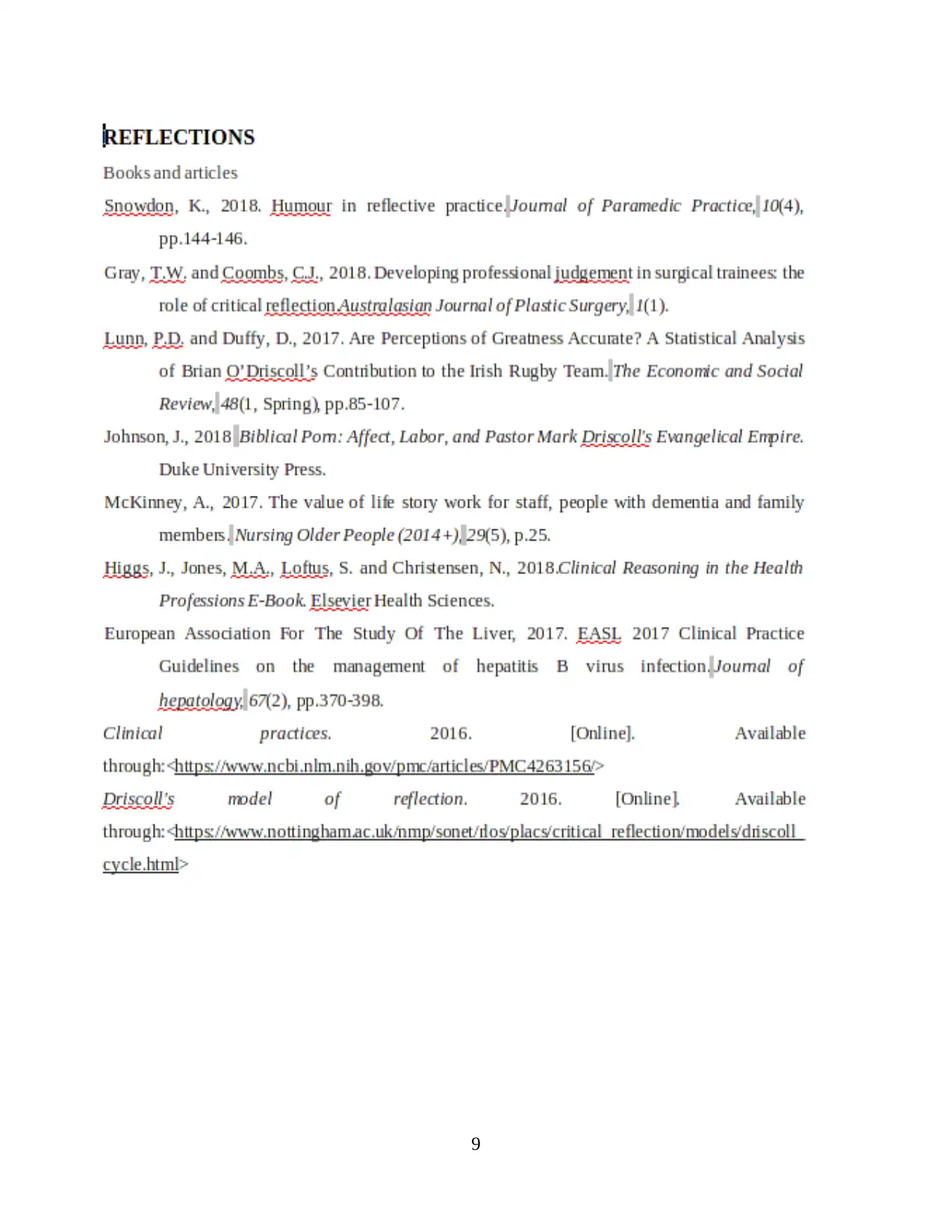
9

10
⊘ This is a preview!⊘
Do you want full access?
Subscribe today to unlock all pages.

Trusted by 1+ million students worldwide
1 out of 12
Related Documents
Your All-in-One AI-Powered Toolkit for Academic Success.
+13062052269
info@desklib.com
Available 24*7 on WhatsApp / Email
![[object Object]](/_next/static/media/star-bottom.7253800d.svg)
Unlock your academic potential
Copyright © 2020–2025 A2Z Services. All Rights Reserved. Developed and managed by ZUCOL.




